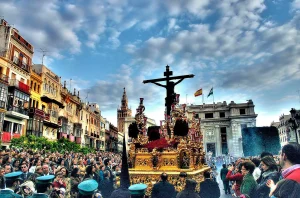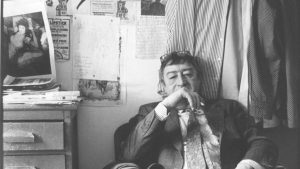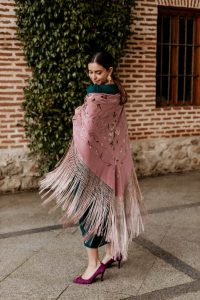
Looking for a barber in Seville
Nevertheless, the magic of that Seville which has been the most cosmopolitan in the world for 150 years, simply by hearsay, caught those writers who needed stories of passionate and impossible love unfolding in “exotic” places. Don Giovanni, Carmen, Fidelio, La Forza del Destino… and the Barber of Seville, of course.
Every Opera story has a crucial setting, without which there wouldn’t be great scripts. It’s not Vienna nor Paris, it is Seville. Some of the best works have Seville as setting for their plots even though their author never sat a foot in the city.
The author of the latter, Pierre-Augustin Caron de Beaumarchais, was a French playwright who was parte of the court of king Carlos III between 1764 y 1765. He came on business and left also for economic reasons as his debts increased.
Two years in Spain were enough to become fascinated by it and unleashed his creativity inspired by the exemplary novel of Miguel de Cervantes “The Jealous Husband”, the same author of Don Quixote.
Beaumarchais wrote the Barber of Seville and The Marriage of Figaro, although the stories did not reach fame until Gioacchino Rossini and Wolfgang Amadeus Mozart adapted them to the opera, respectively (well, there is a third libretto entitled The Guilty Mother with music by Milhaud which did not reach such high popularity).
In the first, Fígaro, the protagonist, is a famous barber in Seville in the late eighteen century who befriends a young nobleman, Count of Almaviva.
The aristocrat, in love with Rosina, an orphan girl who had been kidnapped by her tutor in order to marry her and keep a valuable inheritance, asks for his friend’s help to meet his beloved by fooling the tight surveillance of Don Bartolo, and free her.
In the second story, The Marriage of Figaro, the count and countess of Almaviva get married now,while Figaro helps them preparing for the wedding. However, this time the count betrays Figaro, by trying to seduce his betrothed Susanna, provoking Figaro who will seek revenge.
Although Beaumarchais was never in Seville, the presence of the ordinary people, their rumors and legends made the opera location seem real. A great example is Figaro’s home. It was echoed up by those romantic nineteen-century travellers such as British writer Augustus Halle who, after a trip to Spain, wrote in his Wanderings in Spain (London, 1873): “Just behind the Alcazar is Santo Tomás square where Figaro the barber of Seville had his establishment… it’s strange than no enterprising barber has now been installed there”.
Logically, the urban landscape has now changed, but if we walk from the royal palace down to Santander street, almost at the junction with Constitution Avenue, we may stop, look at the building in front the old mint Casa de la Moneda, and replace it in our imagination with a whitewashed two storey house, maybe with arcades.
At the ground floor, Figaro would attend his customers and shaving them with unrivalled ability. Upstairs his home, where next to Count Almaviva, they both designed the strategy and tricks to free beautiful Rosina.
To experience the rest of the script firsthand, we should head to Santa Cruz and the Abbots neighborhood where narrow, labyrinthine alleys take us back centuries and where Figaro was up to his arrangements and gimmicks.
Then, we may decide to look for Don Bartolo the tutor’s house, and the balcony where Rosina awaited, heard and yearned for her beloved Count of Almaviva disguised under the semblances of the poor student Lindoro.
I locate the famous house right where Camen Laffón does: calle Segovias street, where now is the Hotel Palacio Pinello, few steps from the corner with Argote de Molina street. Carmen Laffón is the stage designer of the beautiful, authentic, perfectly achieved Barber of Seville that we enjoyed last February 2016 at La Maestranza de Sevilla Opera house, during a charming Andalusia tour with Italian Tour Operator Alderan – Note in Viaggio, Rome.
Come to Seville, indulge in its magic, walk its charming little squares and alleys full of legends and stories while crooning Rossini and Mozart. Or maybe Bizet, for two streets from you, prés de remparts de Séville / chez mon ami Lillas Pastia, Carmen might be dancing the Seguidille on the tables of her friend’s tavern next to the city walls! Pin your ears back and you will hear also the knocks beating the rhythm on the wooden tables while dozens of Manzanilla glasses clink in the hands. Where if this? Look for an alley called Callejón del Agua.

Looking for a barber in Seville
Nevertheless, the magic of that Seville which has been the most cosmopolitan in the world for 150 years, simply by hearsay, caught those writers who needed stories of passionate and impossible love unfolding in “exotic” places. Don Giovanni, Carmen, Fidelio, La Forza del Destino… and the Barber of Seville, of course.
Every Opera story has a crucial setting, without which there wouldn’t be great scripts. It’s not Vienna nor Paris, it is Seville. Some of the best works have Seville as setting for their plots even though their author never sat a foot in the city.
The author of the latter, Pierre-Augustin Caron de Beaumarchais, was a French playwright who was parte of the court of king Carlos III between 1764 y 1765. He came on business and left also for economic reasons as his debts increased.
Two years in Spain were enough to become fascinated by it and unleashed his creativity inspired by the exemplary novel of Miguel de Cervantes “The Jealous Husband”, the same author of Don Quixote.
Beaumarchais wrote the Barber of Seville and The Marriage of Figaro, although the stories did not reach fame until Gioacchino Rossini and Wolfgang Amadeus Mozart adapted them to the opera, respectively (well, there is a third libretto entitled The Guilty Mother with music by Milhaud which did not reach such high popularity).
In the first, Fígaro, the protagonist, is a famous barber in Seville in the late eighteen century who befriends a young nobleman, Count of Almaviva.
The aristocrat, in love with Rosina, an orphan girl who had been kidnapped by her tutor in order to marry her and keep a valuable inheritance, asks for his friend’s help to meet his beloved by fooling the tight surveillance of Don Bartolo, and free her.
In the second story, The Marriage of Figaro, the count and countess of Almaviva get married now,while Figaro helps them preparing for the wedding. However, this time the count betrays Figaro, by trying to seduce his betrothed Susanna, provoking Figaro who will seek revenge.
Although Beaumarchais was never in Seville, the presence of the ordinary people, their rumors and legends made the opera location seem real. A great example is Figaro’s home. It was echoed up by those romantic nineteen-century travellers such as British writer Augustus Halle who, after a trip to Spain, wrote in his Wanderings in Spain (London, 1873): “Just behind the Alcazar is Santo Tomás square where Figaro the barber of Seville had his establishment… it’s strange than no enterprising barber has now been installed there”.
Logically, the urban landscape has now changed, but if we walk from the royal palace down to Santander street, almost at the junction with Constitution Avenue, we may stop, look at the building in front the old mint Casa de la Moneda, and replace it in our imagination with a whitewashed two storey house, maybe with arcades.
At the ground floor, Figaro would attend his customers and shaving them with unrivalled ability. Upstairs his home, where next to Count Almaviva, they both designed the strategy and tricks to free beautiful Rosina.
To experience the rest of the script firsthand, we should head to Santa Cruz and the Abbots neighborhood where narrow, labyrinthine alleys take us back centuries and where Figaro was up to his arrangements and gimmicks.
Then, we may decide to look for Don Bartolo the tutor’s house, and the balcony where Rosina awaited, heard and yearned for her beloved Count of Almaviva disguised under the semblances of the poor student Lindoro.
I locate the famous house right where Camen Laffón does: calle Segovias street, where now is the Hotel Palacio Pinello, few steps from the corner with Argote de Molina street. Carmen Laffón is the stage designer of the beautiful, authentic, perfectly achieved Barber of Seville that we enjoyed last February 2016 at La Maestranza de Sevilla Opera house, during a charming Andalusia tour with Italian Tour Operator Alderan – Note in Viaggio, Rome.
Come to Seville, indulge in its magic, walk its charming little squares and alleys full of legends and stories while crooning Rossini and Mozart. Or maybe Bizet, for two streets from you, prés de remparts de Séville / chez mon ami Lillas Pastia, Carmen might be dancing the Seguidille on the tables of her friend’s tavern next to the city walls! Pin your ears back and you will hear also the knocks beating the rhythm on the wooden tables while dozens of Manzanilla glasses clink in the hands. Where if this? Look for an alley called Callejón del Agua.






